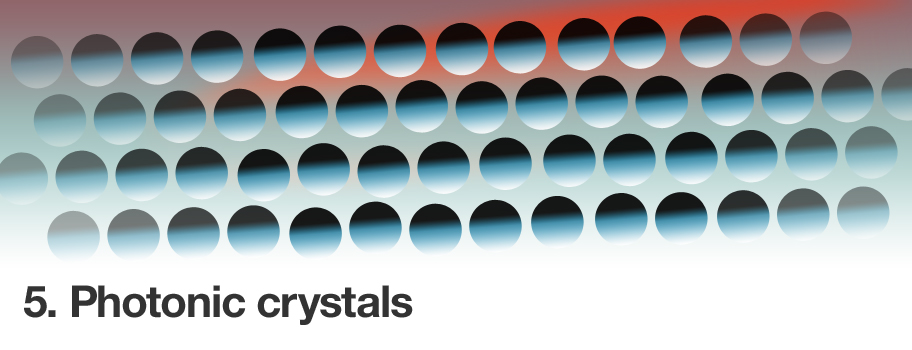How to make an iPhone completely invisible
The race to create the first cloaking device is on

Scientists all over the world are now racing to be the first to create a metamaterial that can bend visible light, and many hope that the computing industry is well placed to lend a hand.
Photolithography is a complex technique that silicon chip manufacturers like Intel and AMD already use to fabricate components that contain billions of microscopic transistors. Ultraviolet light is used to etch the components onto silicon wafers.
It is hoped that a new generation of computer chips will use light instead of electricity to process information, making them faster and far more efficient. These new chips will need billions of crystalline transistors each with a slightly different index of refraction. And that means research into invisibility cloaks can piggyback on work in this field.
In 2007, scientists in the US and Germany used this process to create a multi-layered material that was able to bend red light with a wavelength of 780nm (red being the longest and thus relatively easiest wavelength to bend in the visible spectrum).
"Metamaterials may one day lead to the development of a type of flat superlens that operates in the visible spectrum," says Ames Labratory Senior Physicist Costas Soukoulis. "Such a lens would offer superior resolution over conventional technology, capturing details much smaller than one wavelength of light."
While progress in this field is ongoing, there are still huge obstacles to be overcome.
Photolithography has been shown to be capable of stacking photonic crystals that bend light in two dimensions, but the process is far more complicated when it comes to bending in three dimensions as you'd need to cloak a real-world object like an iPhone. The process might not be capable of it.
Sign up for breaking news, reviews, opinion, top tech deals, and more.
Plus of course, bending more than one wavelength of light around the same object is another enormous challenge in itself, potentially requiring multiple layers of different types of metamaterials.

The military applications of rendering objects invisible are fairly obvious. And as such, military customers are footing the bill for some of the research. Imagine a scary future where the NSA could mount a camera in a room and then cloak it - they'd be able to spy on people without them knowing.
"Ah ha", you say, "but if you're bending light all the way round an object as to make it invisible, how would any light get into the object so that it can observe its surroundings?" That's a good question, and the answer could be plasmonics.
Plasmonics is another candidate technology for tomorrow's super-efficient computer chips, and it's also lending a hand with research into invisibility. Instead of using just light to perform calculations as do photonic crystal-based chips, plasmonics uses a combination of light and electricity - photons and electrons.
One current plasmonic prototype consists of silicon nanowires, coated by a thin layer of pure gold. And its parent researchers at Stanford University have shown that you can effectively cloak a silicon wire in this way while also allowing a small amount of light through to a detector.
It works by using the interaction of photons with the electrons in metal nanostructures to induce oscillating electrical currents on the surface of both the metal and the semi-conducting silicon layer underneath, producing scattered light waves. By tuning the structural geometries of these materials, the light waves from the metal and semiconductors will cancel each other out, rendering any object underneath invisible.
"It seems counter-intuitive, but you can cover a semiconductor with metal - even one as reflective as gold - and still have the light get through to the silicon," says Associate Professor Mark Brongersma at Stanford University. "As we show, the metal not only allows the light to reach the silicon where we can detect the current generated, but it makes the wire invisible, too.".

This week's breakthrough in invisibility at Cambridge University comes thanks to a new technique which uses unfocused laser lights projected into water as proxies for billions of needles, stitching gold nanoparticles together into long strings. These nanostrings are stacked into layers like Lego bricks and are able to control the way that light passes through them making them perfect for invisibility.
Part of the brilliance of this metamaterial is that, by effectively making it out of light itself, it's far easier to make in larger quantities than other candidate metamaterials.
"We have controlled the dimensions in a way that hasn't been possible before," said Dr Valev, who worked with researchers from the Department of Chemistry, the Department of Materials Science & Metallurgy, and the Donostia International Physics Centre in Spain on the project. "This level of control opens up a wide range of potential practical applications."
So we've seen that while invisibility is in its infancy, progress is being made. And one day scientists could feasibly create an invisibility cloak. So when will we see an iPhone that can render itself invisible?
Well obviously the answer, unfortunately, is never. By the time this technology reaches maturity, we'll likely be far beyond using smartphones as everyday gadgets. But the latest news from Cambridge University does at least show that regular progress is being made towards what is now considered a realistic goal.
The invisible future, it seems, is just around the corner.

James was part of the TechRadar editorial team for eight years up until 2015 and now works in a senior position for TR's parent company Future. An experienced Content Director with a demonstrated history of working in the media production industry. Skilled in Search Engine Optimization (SEO), E-commerce Optimization, Journalism, Digital Marketing, and Social Media. James can do it all.